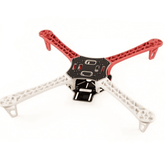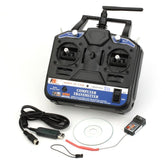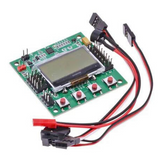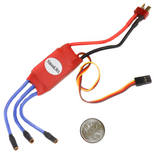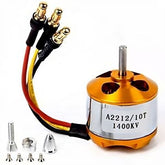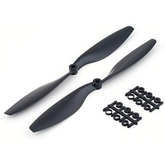Working of A Drone
Summary
Explore the fascinating world of drones in our blog, "Working of A Drone." Learn the ins and outs of how drones work, from their construction using cutting-edge materials to their ability to calculate height and communicate with controllers. Discover the science behind drone flight, including how high and how far they can soar, as well as their weight-carrying capacity and flight duration. Uncover the frequencies and technology that power these aerial wonders. Whether you're a drone enthusiast or a curious beginner, this blog will take you on a captivating journey through the mechanics and marvels of drone technology. Don't miss out – read on for an eye-opening adventure into the world of drones!
How do drones work?
Drones are a unique form of technology that allows users to fly in the air without having to pilot an aircraft. Drones are the perfect way for anyone looking to get into flying these amazing devices on their own terms and with fewer restrictions than those associated with commercial aircraft.
Drones have three main components that work together, making them both powerful and easy to use: a chassis or body frame; motors and propellers; lastly, and radio frequency (RF) controllers for steering controls. The motorized parts help create propulsion while RF links enable control over distance from the user's place either via wireless protocol or remote controller. You can also add external cameras as well as other hardware onto many models of drones giving you extra options when it comes to recording your flight path.

The good thing about most drones is they don't require any special knowledge beyond basic assembly instructions usually provided by manufacturers so even first-time builders should feel comfortable tinkering with one if need be! With just some fundamental tools such as screwdrivers, pliers etc., assembling most kit frames takes only around 30 minutes at max - no prior experience necessary! As long as airspace regulations permit elevation above 400 feet – which vary depending on local laws - then potentially endless possibilities await explorers ready to take off using homemade aerial vehicles!
Explore essential drone parts in our detailed guide!
read more : What are drones? A-Z Guide Of Assembly to Flying
How to make drones?
Drones have become a popular pastime for hobbyists looking to take their creative aspirations to the skies. Building your own drone is not only an incredibly rewarding experience, but it can also help you gain a better understanding of how these incredible machines work and operate. To get started building your very own drone, first source all the necessary drone assembly kit; this could include motors, propellers, flight controllers etc.

Then assemble them together according to step-by-step instructions available online or in manuals from suppliers – be sure to check whether any additional soldering may be required! Next program the flying controls before powering up: make sure all settings are calibrated correctly so that when you launch into flight mode you know exactly what each setting does. Finally, build yourself some safety features such as landing gear for those emergency landings. Flying with care will ensure many hours of fantastic fun experimenting with new designs and improving on existing ones – happy flying!
Assemble your own flying machine with this DIY Drone Kit.
read more : Drone Part List
How do drones fly?
Drones are an exciting addition to the ever-growing world of modern technology. With drones, you can build a unique drone that is customized to meet your own needs and interests. Drones have become increasingly popular over time due to their convenience for photography or mapping applications which allow users to capture stunning aerial footage without having any flying experience.
Drones fly through the use of quadcopter motors controlled with an electronic flight controller, two servos (for roll & pitch control), gyroscopes & accelerometers for stabilization plus a receiver/transmitter setup for remote control operation from a ground station such as radio transmitter (RC). The motor speed in each corner creates lift by pushing air downwards while also creating thrust so that it can move forward and backwards at various speeds; this propulsion creates the aerodynamic balance required when hovering at escape velocity! Additionally, some additional onboard sensors like GPS help maintain navigation stability during autonomous missions where pre-programmed commands take place instead of manual input from RC device – allowing users hands-free access once familiar enough with basics operating procedures on board aircraft via simulator software before engaging in real life operational flights outdoors!
Check out our best DIY Drone Kit with camera and WIFI.
read more : Drone Motor – Where to Begin?
How high can drones fly?
Drones have become extremely popular among tech enthusiasts all around the world. It allows people to create their own custom drone from scratch and explore the new heights of unmanned aerial technology. But when it comes to how high can these homemade drones fly, it depends on several factors like wind conditions, surrounding airspace restrictions and other environmental issues.
Generally speaking, a drone is capable of reaching altitudes ranging anywhere between 200-400 feet (61 meters – 122 meters). This flight ceiling may also extend beyond 400 ft in open areas with no obstructions while taking into consideration prevailing weather conditions as well as FAA regulations applicable for operating such pilotless aircraft over populated zones or regions featuring essential infrastructure elements.
 Moreover, proper maintenance of your self-made UAV unit will determine its actual flying performance & experience along with maximum altitude limitations thereby allowing you to blaze through skies freely without any uncertainties or apprehensions about physical threats posed by certain operational environments at higher elevations if not properly vetted before embarking upon your next expeditionary journey!
Moreover, proper maintenance of your self-made UAV unit will determine its actual flying performance & experience along with maximum altitude limitations thereby allowing you to blaze through skies freely without any uncertainties or apprehensions about physical threats posed by certain operational environments at higher elevations if not properly vetted before embarking upon your next expeditionary journey!
Explore the science behind drone propeller!
How far can drones fly?
Drones are quickly becoming the must-have gadgets of the tech world and with good reason. By assembling a drone yourself, you can customize it to suit your aerial needs while saving money in comparison to purchasing one ready-made from a manufacturer. But just how far can these drones fly?
The distance that drones travel is mainly limited by their battery capacity as well as certain regulatory restrictions that limit altitude or range for safety purposes. Generally speaking, hobbyist modellers have been able to achieve flight distances exceeding 1 kilometre before the signal loss becomes an issue; however this varies depending on several factors such as terrain obstacles, interference in radio waves due to company activities etc., Even if multiple batteries were used concurrently allowing for doubled flight times - limitations still exist regarding air law limits in terms of both speed and maximum height above ground level restriction put up typically at 400 feet across most countries.
To extend battery life during drone operations without compromising much of its efficiency/performance – solar cells added onto them proved quite useful thus eliminating any origination-related constraints towards extended mileages per each charge given enough sun exposure time-wise. However extra caution should be taken since higher altitudes result in more strain on motors/propellers which could lead to unexpected breakdowns & malfunctions along the way when least expected!
How much weight can drones carry?

Drones are capable of carrying a wide range of weights; this is dependent on the type and size of the drone chosen. Generally speaking, they can carry anything from small payloads such as cameras or sensors to larger packages weighing up to several kilograms. This makes them suitable for both recreational use (such as racing) and commercial applications like transporting goods across large distances quickly & safely. The strength of their construction also ensures that these loads remain secure during flight while still allowing manoeuvrability in difficult conditions - something else which adds value when taking into account costs associated with purchasing materials for building our own flying creations!
How long can drones fly?
Drones are becoming increasingly popular for recreational use, but many people wonder how long they can fly. The answer depends on the type of drone and battery used. On average, drones typically have a maximum flight time of around 15-25 minutes with standard batteries; however, this varies depending on factors such as wind speed, payload weight and temperature. If you want an extended range or longer flight times then investing in larger capacity batteries is recommended to maximize your craft’s potential performance capabilities – extending overall flying time up to 40+ minutes if necessary! With high-powered aesthetics at your fingertips, there's no limit when it comes to creating unique aerial experiences through drone applications - allowing you to explore from new perspectives like never before!
How drones are made?
Drones are a marvel of modern technology, made possible through dedicated engineering and innovative design. Crafting these flying vehicles requires expert skill to ensure each drone meets stringent safety standards for flight operations.
The process begins with experienced engineers creating the 3-dimensional frame layout using aluminium alloys or carbon fibre elements that provide structural integrity during use. Once complete, technicians install electrical drone assembly kit such as motors and batteries into specially designed compartments on the exterior framing while ensuring secure attachment points remain integral throughout construction for additional stability in operation.
Next, avionics systems like navigation suites and autopilot sensors help manage performance output based on data collected from various sources including integrated cameras which give operators an eye in the sky via remote control backseat view capabilities inherent within most contemporary models available today across multiple markets globally.
Finally comes testing processes where drones can be programmed to fly autonomously following precise instructions set by their operator before they’re finally cleared for unlocking their full potential capability upon certification regulations are met validating approval status under its country's specific aviation guidelines such as making it ready and certified safe enough to take off without any technical issues or difficulties so users may enjoy them confidently comfortably exclusively no matter what environment nature throws at it anytime anywhere in absolute assurance after numerous quality checks have been performed successfully demonstrating reliable results when needed even beyond expected expectations quickly & seamlessly each time!
Look out our various collections of Drone Parts for Beginners.
What materials are used for drones?
Drones are designed and manufactured with a variety of materials for specific purposes. Uniquely lightweight composites such as carbon fibre, Kevlar, and rubberized foam enable drones to fly safely while remaining durable in harsh conditions. Polypropylene components provide high-strength support structures that can take heavy loads during operation without sacrificing weight or manoeuvrability.
Lithium batteries supply the stable power needed for flight duration as well as electronic parts like speed controllers used to regulate motors' performance according to their respective commands from ground control systems. Highly heat-resistant ceramic coating is often applied on certain drone models which provide extra protection against extreme temperatures encountered at higher altitudes or close proximity fire situations like military operations where it will be vulnerable due to thermal signatures registered by adversaries' detection systems.
How do drones calculate the height?
Drones calculate their height using a variety of techniques. First, they take advantage of barometric pressure sensors present in many modern drones which measure the air pressure around them to help determine altitude. Additionally, advanced drone models make use of ultra-precise GPS altimeters that can accurately sense and map changes in elevation down to within one metre or less. Finally, some manufacturers have developed special vision algorithms for quadcopters which utilize computer vision systems such as stereo depth cameras coupled with traditional sensor fusion processing methods for even greater accuracy when measuring height from above the ground.
How to fly drones?
Learning to fly drones is an exciting experience for everyone. With the right tools and guidance, it's easy to get started. First, read all safety instructions before getting in the air with your drone and familiarize yourself with its control systems. Then practice simple maneuvers like take-off, hovering in one spot or gentle turns on level ground until you become comfortable flying your drone slowly around a large open space away from any obstacles or people. To progress further challenge yourself by performing tricks such as flips and rolls! Lastly be sure to stay up-to date on local laws regarding unmanned aerial vehicles so that when you’re ready show off what pilots can do safely have fun without breaking any rules!
read more : Affordable Drone Batteries
What frequencies do drones use?
Drones use a variety of frequencies to communicate with each other and the remote pilot. These frequencies are divided into two primary categories: radio frequency (RF) waves, which allow for short-range communication; and satellite signals, used for long range communications over large distances. Radio frequency bands such as 2.4 GHz or 5GHz transmit data within local networks while satellites enable global connectivity at higher bandwidths like 1Gbps or more depending on altitude and weather conditions. The combination of these technologies allows drones to take high definition aerial photos, send real time video footage back from afar distance locations & track their location in 3 dimensional space using GPS navigation systems - making them an effective tool across many industries ranging from agriculture to security surveillance operations!
How drones communicate with controller?
Drones are becoming increasingly popular as a tool for hobby, commercial and military use. The ability of these unmanned aerial vehicles to communicate with their controller is an integral part of what makes them so useful.
Communication between a drone and its controller typically involves the transmission of data or commands via radio signals. These signals travel from the remote control station up to several kilometers away depending on terrain features such as hills, buildings or even trees that could obstruct the signal’s path and effect communication range accordingly. To facilitate long distance communications most drones have specialized antennas allowing them backhaul capabilities over considerable distances using line-of-sight links in good weather conditions.

In addition many modern drones also employ Wi-Fi networks enabling local wireless communications by employing dedicated base stations which transport information securely across short ranges at high speeds – making it possible for pilots located close enough within direct view reach each other without any special equipment being required beyond those built inside existing models adorned with highly sensitive receivers capable retaining constant contact despite potential heavy EMF interference around them while remaining airborne above our heads performing wide variety operational maneuvers in real time environment befitting all sector types mentioned earlier.
read more : Upgrade Your Control: Best Drone Remote Controllers
What technology do drones use?
Drones are cutting-edge technology, leveraging advanced capabilities to provide innovative solutions. They use a combination of sensors and software for navigation and operation–including GPS, ultrasonic altimeters, IMUs (inertial measurement units), computer vision systems, 3-axis electronic compasses along with proprietary algorithms in the background that enables them to function autonomously. Drones also rely on light electronics such as low-power WiFI or LTE data links used for communication between controller devices at ground level and drone 'brains' which host their flight control applications. The combination of these technologies grants drones an unprecedented level of operational freedom unseen before now – allowing us to revolutionize operations ranging from survey mapping through industrial inspection right up agricultural crop analysis!
Conclusion:
The world of drones is a fascinating blend of technology, engineering marvels, and limitless possibilities. We've unraveled the intricacies of how drones work, delved into the process of making them, and explored their capabilities in terms of altitude, range, payload, and flight duration. From the materials that form their structures to the frequencies they operate on, we've covered it all. Drones are more than just gadgets; they're a testament to human innovation. So, whether you're a drone enthusiast or just curious about this rapidly evolving technology, it's clear that the sky's the limit when it comes to the world of drones. Get ready to take flight into a future where the horizon is boundless, and the opportunities are endless!
If you appreciate our work don't forget to share this post and leave your opinion in the comment box.
Please do check out other blog posts about Popular electronics
Make sure you check out our wide range of products and collections (we offer some exciting deals!)



